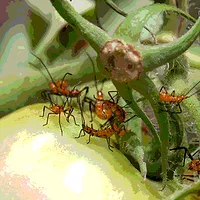Insects and Integrated Pest Management
Integrated pest management programs are essential to deal successfully with insect pest problems. Since there are so many insects that could potentially be in a facility, the first step is to identify the species. Once a correct identification has been established, the specific needs and biology of the pest can be used to pinpoint where they are coming from and limit their damage. Knowing that warehouse beetles typically infest finished product means you can isolate your inspections to warehouse areas. Finding weevils means incoming whole grain is where the problem is originating. Using an insect’s specific biology can also be employed. For example, knowing that Indian meal moths must mate within 3 days to produce fertile eggs, you can utilize mating disruption to prevent that.
Sanitation is one of the most important steps you can take to minimize infestations. Without a food source, or with limited food resources, insects will have a difficult time establishing. By quickly cleaning spills and by-products, and removing or containing that material will prevent insects from discovering it. Since insects are small and don’t require a lot of food, sanitation will never be able to eliminate all food sources, but it will greatly minimize the potentially exponential populations of insects that have unlimited resources.
Inspecting for insects is a challenge due to their small size. They are able to utilize any crack and crevice, hole in the structure or entry point into a piece of machinery. A close inspection of incoming goods is the fist step in preventing insects from entering your facility. A set weekly or monthly inspection of the facility that includes inside production machinery is also necessary to find and quickly eliminate any insects found. This inspection should also look for conditions that may be conducive to potential infestations as well as direct evidence of insects. Finally, inspecting empty transport vehicles before your product gets shipped out is necessary to prevent your finished good becoming contaminated in transit.
A monitoring program is a great way to ascertain which insects may be present in a facility, where they are and the change in population over time. Dome traps for crawling insects like flour beetles should be placed flat to the floor along a wall. Sticky traps for flying insects like Indian meal moths should be hung at eye level with both openings unobstructed. Light traps for insects like houseflies should be placed no higher than five feet high and where natural light sources will not compete with them. Checking these traps on a regular basis is important to track population changes and potential hotspots of insect infestation. If you suddenly discover many insects in a trap that, in the past, has only had a few, you can concentrate sanitation and inspection efforts in that area. You can also increase the number of traps in a location to further pinpoint suspected problem areas.
While it may sound like common sense, exclusion tactics and physical controls are important to keep insects out in the first place. The simple fact of keeping doors and windows closed will have a big impact on the possibility of insects gaining entry. Make sure screens are properly installed and maintained. All cracks and crevices should be sealed to eliminate harborages for small insects. Any opening from the outside of the facility to the inside, such as air handling systems and vents, should be properly screened or sealed.
If necessary, chemical control can be utilized as a final step. There are many chemical pesticide options, from crack and crevice treatments, to foggings and fumigations. Carefully read and follow all label instructions. Many pesticides are restricted use and require a certified applicator.
A preventative management plan is always better than a reactionary plan. Keeping a facility cleaned and well maintained will reduce insect populations and prevent them from becoming established. Monitoring will provide valuable information about what insects and how many are present in different areas of a facility. Once all these options have been employed, chemical pesticides can be used as a last step.
For more information on integrated pest management tactics or any other pest management questions, please feel free to contact The Industrial Fumigant Company at 913-785-7600 or www.indfumco.com.
Looking for quick answers on food safety topics?
Try Ask FSM, our new smart AI search tool.
Ask FSM →







.webp?t=1721343192)